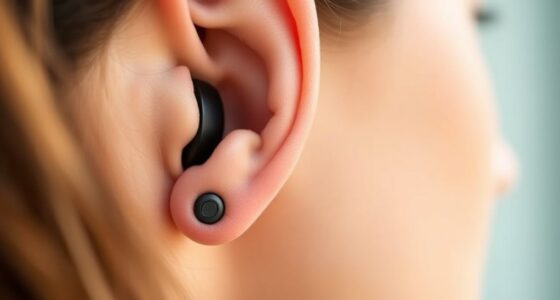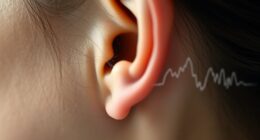Over the past year, the OTC hearing aid market has expanded considerably, making devices more accessible and affordable. You’ll find lower prices, innovative features like wireless connectivity, and easier ways to buy online or in stores. Consumer attitudes have shifted from skepticism to acceptance, boosted by education and positive reviews. As direct-to-consumer sales grow, traditional services are evolving. To discover how these changes impact you, explore what’s next in the industry.
Key Takeaways
- The OTC hearing aid market has expanded, increasing accessibility through online sales, retail options, and reduced costs.
- Consumer awareness and acceptance have grown, driven by education, positive reviews, and healthcare endorsements.
- Technological innovations now include wireless connectivity, discreet designs, and customizable features via smartphone apps.
- Direct-to-consumer sales have reduced reliance on traditional providers, prompting industry shifts and integration of telehealth services.
- Regulatory improvements and increased competition have fostered innovation, safety standards, and market segmentation.
The Evolution of Consumer Awareness and Attitudes

Over the years, consumer awareness of OTC hearing aids has grown considerably, shifting perceptions from skepticism to acceptance. Many people initially doubted the effectiveness and safety of these devices, fueled by consumer skepticism. However, increased education, positive reviews, and endorsements from healthcare professionals have helped change attitudes. As more users share success stories, the stigma reduction around hearing aids has gained momentum. You now see hearing aids as practical, accessible solutions rather than symbols of aging or disability. This shift encourages more individuals to contemplate OTC options confidently. The evolving perception reflects a broader understanding that hearing health is essential and approachable, breaking down long-standing barriers rooted in misinformation and social stigma. Additionally, smart marketing strategies have played a crucial role in informing consumers and shaping positive attitudes toward OTC hearing aids. Moreover, advancements in hearing aid technology have contributed to improving user satisfaction and trust in these products. Recognizing the importance of consumer education, many organizations now focus on providing accurate information to dispel myths and misconceptions. Increased regulations and standards have also increased consumer confidence by ensuring product safety and quality. A focus on market transparency has further supported consumer trust and informed decision-making in this evolving landscape.
Increased Accessibility and Affordability of Hearing Devices

With more affordable options now available, you can access hearing devices without breaking the bank. The wider variety of devices on the market means you’re more likely to find one that fits your needs and budget. Increased accessibility makes managing hearing health easier and more convenient for you. Additionally, fraud detection software offers enhanced security features that help protect your transactions and personal information, further supporting your purchasing choices for hearing aids.
Lower Cost Options
Lower-cost OTC hearing aids are making it easier for more people to access essential hearing support without breaking the bank. This cost reduction results from increased price competition among manufacturers, driving down prices and expanding options for consumers. As more brands enter the market, they challenge traditional pricing models, offering affordable devices that meet quality standards. These lower prices remove financial barriers, allowing those who previously couldn’t afford hearing aids to seek help. With more affordable options available, you can now choose devices that fit your budget without sacrificing performance. The emphasis on cost reduction and competitive pricing has fundamentally shifted the market, making hearing aids more accessible to a broader audience and encouraging market innovation in affordable device technology. Additionally, the availability of organic and natural juices demonstrates how health-conscious options are becoming more accessible and affordable across various sectors. This trend mirrors how regulatory changes and other wellness practices are gaining popularity because of their accessibility and benefits for mental health.
Wider Device Availability
As the market for OTC hearing aids expands, more people now have easier access to the devices they need. This broader availability is driven by improvements in device design and a streamlined supply chain. Here’s how it benefits you:
- Greater variety – With diverse device designs, you can find hearing aids that fit your preferences and lifestyle.
- Lower costs – An efficient supply chain reduces manufacturing expenses, making devices more affordable.
- Wider distribution channels – Hearing aids are now available online and in retail stores, increasing your options for purchase.
- Enhanced accessibility – Increased device availability supports market growth and innovation, making it easier for more people to benefit from OTC options.
These changes mean you no longer face limited choices or high prices, ensuring more people can access effective hearing solutions whenever they need them.
The Rise of Direct-to-Consumer Sales Channels

You’re now seeing how direct-to-consumer sales channels make purchasing hearing aids more accessible and convenient. These channels often lower cost barriers by eliminating middlemen, making devices more affordable. Additionally, brands use direct engagement strategies to build stronger relationships and better understand your needs. As part of this shift, some companies incorporate trustworthiness of Patchology products into their offerings to enhance customer experience through natural wellness options. Furthermore, the rise of direct sales channels has prompted a reevaluation of traditional distribution models within the hearing aids industry, fostering greater transparency and customer empowerment. This evolution mirrors trends seen in other health-related sectors, such as juice cleansing, where accessible, consumer-focused options are increasingly valued. The emphasis on financial management within these businesses also encourages transparent pricing and clear communication, fostering trust and loyalty among consumers.
Increased Accessibility and Convenience
The rise of direct-to-consumer sales channels has considerably boosted the accessibility and convenience of OTC hearing aids. You now have easier access to a wider range of products, tailored to various consumer demographics. This shift enhances market segmentation, allowing manufacturers to target specific groups more effectively. Here are three key benefits:
- Wider reach: You can purchase hearing aids online or at retail stores, removing geographical barriers.
- Tailored options: Products are designed for diverse needs, age groups, and lifestyles, making it easier to find suitable devices.
- Simplified process: You bypass complex procedures, enabling quicker, more straightforward access to hearing solutions.
- Additionally, the increased availability of OTC hearing aids has encouraged market innovation and competition within the market, leading to better options for consumers. This expansion also underscores the importance of regulatory oversight to ensure safety and quality standards are maintained. As AI-driven tools become more integrated into healthcare, ongoing regulatory evolution will be essential to adapt to these technological advancements. Moreover, increased consumer engagement through these channels has fostered greater market transparency, empowering individuals to make informed decisions about their hearing health.
Lower Cost Barriers
The expansion of direct-to-consumer sales channels has substantially lowered the cost barrier for acquiring hearing aids. By bypassing traditional retail and clinician fees, manufacturers implement innovative pricing strategies, making devices more affordable. This shift also emphasizes consumer education, helping you understand your options without middlemen. As a result, more people access hearing solutions at a lower price point. market evolution plays a crucial role in facilitating this transformation, ensuring that advancements in accessibility continue to benefit a broader population. Additionally, Electricity production from bike generators has become a notable alternative energy source, further supporting sustainable practices. Here’s a quick comparison:
| Feature | Traditional Retail | DTC Channels |
|---|---|---|
| Pricing strategies | Higher, markup included | Lower, competitive pricing |
| Consumer education | Limited in-store info | Online resources & support |
| Cost | $2,500 – $5,000+ | $399 – $1,000 |
Direct Engagement Strategies
As direct-to-consumer (DTC) sales channels grow, manufacturers are actively engaging customers through personalized online experiences and targeted marketing. You’ll notice they leverage customer testimonials to build trust and showcase real-life success stories. Additionally, social media campaigns are tailored to reach specific audiences, creating a sense of community and authenticity. To maximize engagement, companies focus on:
- Sharing authentic customer testimonials across platforms to influence buying decisions.
- Running targeted social media ads that highlight product features and benefits.
- Offering interactive online tools, like virtual consultations, to personalize the shopping experience.
These strategies help brands connect directly with consumers, foster loyalty, and make the path from interest to purchase smoother and more transparent.
Innovations in Technology and Product Features

Advancements in technology are transforming OTC hearing aids, making them more accessible and user-friendly than ever before. You now benefit from wireless connectivity, allowing seamless pairing with smartphones and other devices for streaming calls and music. Battery innovations have also extended usage time and reduced size, making devices more convenient. These features improve your overall experience, providing clearer sound and easy adjustments. The table below highlights key technological innovations:
| Feature | Benefit | Example |
|---|---|---|
| Wireless Connectivity | Stream audio directly | Connect to smartphones for calls |
| Battery Innovations | Longer, smaller batteries | All-day use without frequent charging |
| Noise Reduction | Clearer sound in noisy places | Enhanced speech clarity |
| Customization Apps | Personalize settings | Adjust sound profiles easily |
| Miniaturization | Discreet, comfortable design | Less visible, more comfortable |
Impact on Traditional Hearing Care Services

While OTC hearing aids increase accessibility, they also challenge traditional hearing care services by allowing you to bypass in-person consultations and professional fittings. This shift impacts the industry in several ways:
OTC hearing aids challenge traditional services by enabling users to bypass in-person consultations and professional fittings.
- Telehealth integration becomes essential as professionals adapt to remote support, guiding users through troubleshooting and adjustments.
- You may see a decline in in-office visits, prompting providers to innovate ways to stay connected with clients and maintain trust.
- Professional collaboration shifts toward digital platforms, emphasizing the importance of ongoing communication between audiologists and patients even when in-person visits decrease.
These changes push traditional services to embrace technology, ensuring they remain relevant and effective in a market increasingly driven by OTC options.
Regulatory Changes and Industry Standards

Regulatory changes are shaping the OTC hearing aids market by establishing new standards for safety, efficacy, and consumer access. These updates require manufacturers to prioritize regulatory compliance, ensuring their products meet strict safety guidelines before reaching consumers. Industry standards now emphasize rigorous testing and clear labeling, giving users confidence in OTC devices. These regulations aim to simplify the approval process while maintaining high quality, encouraging innovation without compromising safety. As a result, consumers benefit from increased access to affordable, reliable hearing solutions. Manufacturers must adapt quickly to stay compliant, fostering a safer, more transparent market. Overall, these regulatory changes are driving industry standards upward, ensuring OTC hearing aids are both effective and safe for widespread use.
Market Competition and New Entrants

As regulatory changes reshape the OTC hearing aids market, they also open the door for increased competition and new players to enter the industry. You’ll notice that market saturation is growing, with more brands vying for consumer attention. To stand out, companies focus on brand differentiation through unique features, pricing, and marketing strategies.
Consider these factors:
In a crowded market, differentiation and brand loyalty are more crucial than ever.
- Increased number of startups and established brands entering the space
- Greater pressure on existing companies to innovate and distinguish
- Consumers benefit from more choices, but differentiating your brand becomes vital in a crowded market
With more entrants, competition intensifies, making it essential for brands to carve their niche and build loyalty.
Future Trends and Opportunities in OTC Hearing Aids

The OTC hearing aids market is poised for significant growth as technological advances and shifting consumer preferences create new opportunities. Future trends will likely focus on refined market segmentation, allowing manufacturers to target specific demographic groups more effectively. As more consumers seek accessible solutions, there’s a growing need for enhanced consumer education to help users understand device features and proper usage. Innovations in device connectivity, AI integration, and design customization will make OTC hearing aids more appealing and user-friendly. Additionally, increased emphasis on education will enable consumers to make informed decisions, boosting adoption rates. Overall, these trends create a dynamic landscape where companies that prioritize tailored solutions and clear communication stand to benefit most in the evolving OTC hearing aids market.
Frequently Asked Questions
How Have Insurance Policies Adapted to OTC Hearing Aid Coverage?
You’ll find that insurance coverage and reimbursement policies have become more flexible with OTC hearing aids. Many insurers now recognize their importance and are updating policies to include OTC options, making hearing care more accessible. Reimbursement policies are also evolving, allowing you to get partial coverage or discounts. This shift helps you save money and encourages you to explore OTC hearing aids as a viable, affordable solution for hearing assistance.
What Demographic Groups Are Most Likely to Benefit From OTC Hearing Aids?
You’ll find that elderly consumers and tech-savvy users benefit most from OTC hearing aids. Elderly individuals often seek affordable, accessible solutions for hearing loss, while tech-savvy users appreciate the convenience of easy-to-use devices they can manage independently. These groups gain increased independence and improved communication, making OTC hearing aids a valuable option. Whether you’re new to hearing aids or comfortable with technology, OTC options cater to your needs effectively.
How Do OTC Hearing Aids Compare in Quality to Traditional Devices?
You might wonder how OTC hearing aids compare to traditional devices, especially regarding quality. While OTC models often offer decent sound quality, they usually lack the device customization that helps achieve ideal hearing. Traditional devices typically provide better sound clarity and tailored adjustments, making them more suitable for complex hearing needs. However, OTC aids are more accessible and affordable, making them a good option for mild to moderate hearing loss.
Are There Potential Risks Associated With Unsupervised OTC Hearing Aid Use?
You might think using OTC hearing aids is simple, but beware of self-diagnosis risks and device malfunction concerns. Without professional guidance, you could misjudge your hearing loss or damage your ears. Unsupervised use increases the chance of ineffective sound quality or unnoticed issues. Always be cautious—consult a healthcare professional if uncertain, because a small mistake could lead to bigger hearing health problems down the line.
How Will Ongoing Technological Advances Shape Future OTC Hearing Aid Options?
Ongoing technological advances will markedly shape future OTC hearing aids, giving you smarter integrations like Bluetooth and app control, making adjustments easier. You’ll also benefit from more customization options, allowing your devices to better suit your hearing needs. As technology evolves, expect more user-friendly designs that improve sound quality and ease of use, empowering you to manage your hearing health independently with confidence and convenience.
Conclusion
Over the past year, the OTC hearing aid market has blossomed like a vibrant garden, transforming the way you access and experience hearing solutions. With increased accessibility, innovative tech, and greater competition, you now have more options than ever to find affordable, effective devices. This evolving landscape promises exciting opportunities ahead, making it easier for you to hear the world clearly and confidently. Keep an eye on these changes—they’re shaping your future in hearing care.











